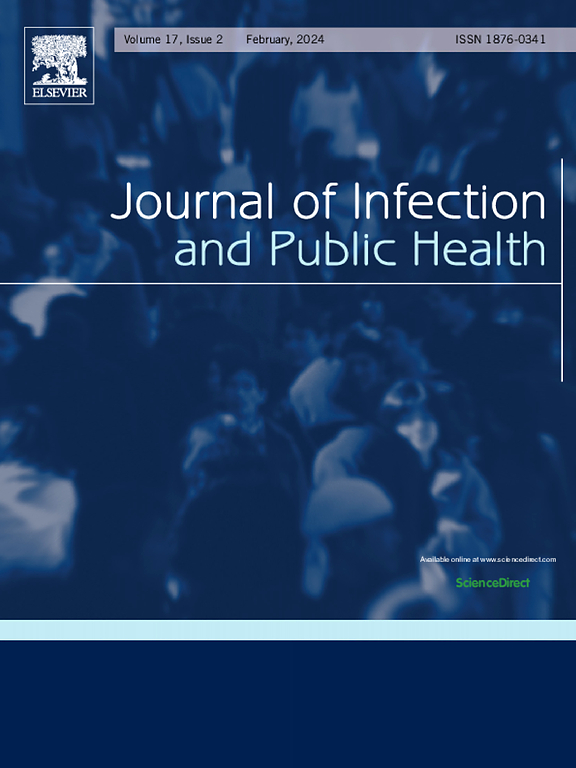Human Papillomavirus (HPV) prevalence in population younger than 12 years old: A meta-analysis and systematic review
IF 4
3区 医学
Q1 INFECTIOUS DISEASES
引用次数: 0
Abstract
Background
The prevalence of HPV in children has been studied in different populations; however, the heterogeneity between the investigations is remarkable, and the total prevalence of HPV infection in this population is not well understood.
Methods
The conducted studies on the prevalence of HPV infection in the population < 12 years old were explored and analyzed through a systematic review and meta-analysis approach. The studies which investigated HPV detection in oropharyngeal, nasopharyngeal and/or anogenital samples were included. HPV prevalence, sample type and age were considered as the inclusion criteria for the meta-analysis.
Results
Fifteen published studies between 1994 and 2021 with a total number of 2638 children aged from 1 day to 12 years, were analyzed. The total HPV prevalence in this population is estimated to be 14.7 % with the highest rate in kids over 1 year old, accounting for 25.4 %. Furthermore, the type of samples showed that buccal swabs had the highest rate of infection. The ratio of HPV-positive children born to HPV-positive mothers varied from 3 % to 55 % (median: 17.5 %), while this ratio decreased to 0–19.7 % (median 5.55 %) in HPV-positive kids born to HPV-negative mothers.
Conclusion
According to the present analysis, the prevalence of HPV in children is relatively high and requires further prospective studies and monitoring HPV acquisition in the young population, specifically in those born to HPV-positive mothers. Follow-up studies to assess the persistency rate of HPV after infancy are needed in order to highlight any possible implications for HPV vaccination programs and policy-making.
人乳头瘤病毒(HPV)在12岁以下人群中的流行:一项荟萃分析和系统评价
背景:在不同人群中对儿童HPV患病率进行了研究;然而,调查之间的异质性是显著的,HPV感染在这一人群中的总患病率尚不清楚。方法采用系统综述和荟萃分析的方法,对已开展的12岁人群中HPV感染的流行情况进行探讨和分析。包括口咽、鼻咽和/或肛门生殖器样本中HPV检测的研究。HPV患病率、样本类型和年龄被认为是meta分析的纳入标准。结果分析了1994年至2021年间发表的15项研究,共涉及2638名年龄在1 天至12岁之间的儿童。这一人群的HPV总患病率估计为14.7% %,其中1岁以上儿童的患病率最高,占25.4% %。此外,样本类型显示口腔拭子的感染率最高。hpv阳性母亲所生hpv阳性儿童的比例从3 %到55 %不等(中位数:17.5 %),而hpv阴性母亲所生hpv阳性儿童的比例下降到0-19.7 %(中位数5.55 %)。结论根据目前的分析,HPV在儿童中的患病率相对较高,需要进一步的前瞻性研究和监测年轻人群,特别是HPV阳性母亲所生人群的HPV感染情况。为了强调HPV疫苗接种计划和政策制定的任何可能的影响,需要对婴儿期后HPV持续率进行评估的随访研究。
本文章由计算机程序翻译,如有差异,请以英文原文为准。
求助全文
约1分钟内获得全文
求助全文
来源期刊

Journal of Infection and Public Health
PUBLIC, ENVIRONMENTAL & OCCUPATIONAL HEALTH -INFECTIOUS DISEASES
CiteScore
13.10
自引率
1.50%
发文量
203
审稿时长
96 days
期刊介绍:
The Journal of Infection and Public Health, first official journal of the Saudi Arabian Ministry of National Guard Health Affairs, King Saud Bin Abdulaziz University for Health Sciences and the Saudi Association for Public Health, aims to be the foremost scientific, peer-reviewed journal encompassing infection prevention and control, microbiology, infectious diseases, public health and the application of healthcare epidemiology to the evaluation of health outcomes. The point of view of the journal is that infection and public health are closely intertwined and that advances in one area will have positive consequences on the other.
The journal will be useful to all health professionals who are partners in the management of patients with communicable diseases, keeping them up to date. The journal is proud to have an international and diverse editorial board that will assist and facilitate the publication of articles that reflect a global view on infection control and public health, as well as emphasizing our focus on supporting the needs of public health practitioners.
It is our aim to improve healthcare by reducing risk of infection and related adverse outcomes by critical review, selection, and dissemination of new and relevant information in the field of infection control, public health and infectious diseases in all healthcare settings and the community.
 求助内容:
求助内容: 应助结果提醒方式:
应助结果提醒方式:


